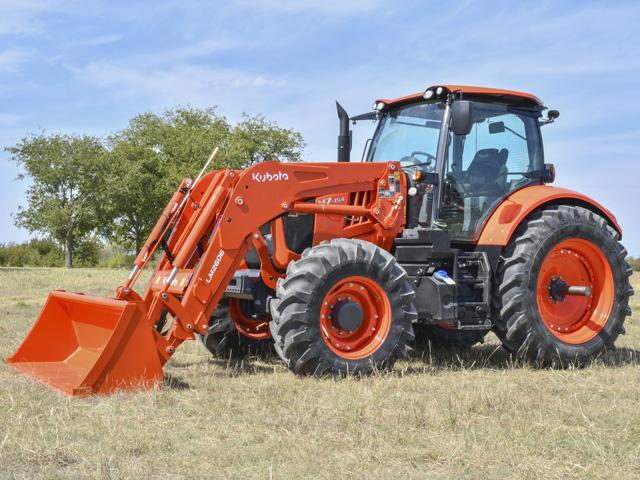Utilities Carry September Tractor Sales
Utility Tractors, Combines Continue Positive Monthly Sales
GRAPEVINE, Texas -- It is two-wheel drive, 100-plus horsepower tractors and combines that are bright spots in a difficult ag power market. This, according to the September 2022 U.S. Ag Tractor and Combine Report. The report is a monthly review of tractor and combine sales activity compiled by Association of Equipment Manufacturers (AEM).
Tractor manufacturers sold 2,402 two-wheel drive, 100 hp-plus units in September, up 9.6% from sales reported in September 2021. These are tractors use for haying, mowing and in smaller-scale planting settings.
For the year, two-wheel drive sales are up, as well. The industry and its dealer networks have moved 18,146 two-wheel drive, 100 hp+ units of their lots through the first nine months of 2022. That's up 11.6% over the same period in 2021.
"That 100 to 200 horsepower tractor [Kubota] offers, we're seeing a good sales trend in livestock and hay customers," said Emily McNerney, product manager for the M5 though M8 series at Kubota. DTN/Progressive Farmer spoke with McNerney at the Kubota Connect this week in Grapevine, Texas. Kubota is marking 50 years in the U.S. tractor market and offering its dealers previews of new equipment, among them Kubota's fourth generation M7. "A lot of lease units are going out and we're seeing a lot of cash deals. The markets we are focused in on will continue to see sales go up," she said.
AEM describes the ag equipment market as turbulent. "Farmers want to take advantage of the efficiency gains and technology that new equipment brings to their operations, especially with commodity markets being as positive as they are. However, supply chain difficulties continue to weigh on our member manufacturers' deliveries," Curt Blades, AEM's senior vice president, industry sectors and product leadership, said in the new report.
P[L1] D[0x0] M[300x250] OOP[F] ADUNIT[] T[]
Kubota described its supply chain strategy at Kubota Connect -- an annual meeting of the manufacturer's dealers.
"We know the number one dealer concern, we're hearing it loudly here, is supply," Kubota's Todd Stucke told DTN/Progressive Farmer on Wednesday. "We have to look at capacity [and] we're working to localize [parts] supply."
Stucke explained that localizing parts supply means Kubota is reaching out to a range of 400 miles from one of its production facilities to identify locally produced parts not already produced by Kubota. Stucke is senior vice president, marketing, product support and strategic projects, Kubota Tractor Corporation and senior vice president for sales and marketing, Kubota North America.
The manufacturer, Stucke said, is devoting a significant piece of the Japanese manufacturer's $1.2 billion investment in the U.S. this year to both boost manufacturing capacity. For example, Kubota is building a new, 650,000 square foot, $140 million loader assembly plant in Gainesville, Georgia. There is an existing facility only 30 miles away in Jefferson, Georgia that also produces loaders. But Kubota wants to free space there to expand its attachment and implement production. That plant is scheduled to open in 2024.
AEM also reported farmers continue to upgrade their combine fleet. Manufacturers sold 904 combines last month, up 6.6% compared to September 2021. For the year through September combine sales up 3.4% compared to the same period in 2021. Year to date sales of combines total 4,555 units.
Factors behind the increase in combine sales? One reasonable thought would be that farmers are upgrading their harvest management technologies.
Down still in recent months are sales of tractors in the lower horsepower ranges, those below 100 hp. AEM reports that sales of less than 40 hp tractors were down 16.3% in September, compared to September 2021 (13,678 sold, compared to 16,360 a year ago). Sales of 40-100 hp tractors are down 10.2% (5,744 sold last month, 6,394 sold in September 2021).
These two tractor horsepower categories were bright stars in the early days of COVID when larger equipment sales tumbled. In those early days, small landowners moved their work home and found new need in their off time for the versatility of these tractors. Sales rose by many hundreds per month for more than a year. But as employees returned to their places of work, sales of smaller of tractors have steadily declined. Historically, these remain good sales numbers, still. One tractor industry exec said off the record that today's consumer small tractor sector may have "checked up, but not for long."
The AEM report reports sales of commercial ag-sized four-wheel drive tractors. That category also registered a decline in September, down 33.1% compared to September 2021 and down 10.6% year-to-date compared to the first nine months of 2021. Big, expensive four-wheel-drive tractor unit sales are fairly modest in raw numbers -- 247 four-wheel-drive tractors sold in September, compared to 369 September, a year ago.
For the first nine months of this year, compared to the same period in 2021, four-wheel-drive unit sales are 2,136 tractors this year compared to 2,390 four-wheel-drive tractors sold in the same months in 2021.
Dan Miller can be reached at dan.miller@dtn.com
Follow him on Twitter @DMillerPF
(c) Copyright 2022 DTN, LLC. All rights reserved.



